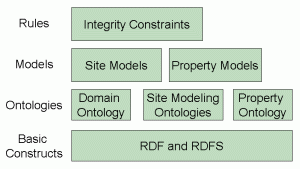
Frequently Asked Questions (FAQ)
OntoWebber is a Web site management system, which facilitates the creation, generation and maintenance of Web sites. Using OntoWebber, site engineers can build site models for domain-specific Web sites. The site models are based on explicit ontologies including the domain ontology and four distinct site-modeling ontologies. Using a RDF-aware rule engine, rules can be defined to check integrity constraints on the resulting site models, thus enforcing desirable properties of the materialized Web site. Both ontologies and site models are expressed using RDF(S)/XML languages. Rules are defined in the F-logic format. The prototype system provides an Integrated Development Environment (IDE) for site engineers to performed all the above tasks for managing Web sites.
What is OntoWebber's definition of a Web site?
The common notation of a Web site is a set of dynamic or static Web pages. In OntoWebber, a Web site in terms of this common notation is called an instantiated Web site. Given a set of source data (possibly integrated from diverse data sources), site engineers can create multiple Web site instances. Each site instance is called a site-view. Site-views differ in their navigational structure, set of selected data content from the source data, and the presentation features. The site-view is described using RDF(S)/XML languages as four site models. For checking integrity of the site models, there are property models and rules defined for this purpose. Thus, a Web site has a broader meaning in OntoWebber. It contains the ontologies, the site models, the property models, and the source data.
What is the modeling hierarchy used by OntoWebber?
OntoWebber adopts a layered modeling approach (see Figure 1). The upper-layer components builds upon the lower ones. A domain ontology describes the structured relationships between all the concepts and their properties in the domain of interest (note that we are building domain-specific Web sites). Site modeling ontologies provide basic vocabularies to describe an instance Web site. Site models describe an instance Web site based on the domain ontology and site modeling ontologies. The property ontology defines vocabularies for the purpose of defining rules to check integrity constraints. Property models are defined based on the property ontology.

Figure 1 The modeling hierarchy
We use the same definition for the SKC project. The SKC project defines an ontology to be a set of terms and their relationships.
Terms refer to real-world and to abstract objects. Abstract objects are concepts which in turn can refer to sets of other abstract objects and real-world objects. The collections of real-world objects provides a grounding for the definitions, and an opportunity for validation of the meaning of the terms being employed. The mapping of terms to objects will differ in various autonomous domains.
Relationships have semantic, and derived from that, structural significance. We may want to follow Sowa in keeping the number of relationship types constrained. Multiple semantic relationship types may share structural relationship types, as IS-A, Ownership, Part-of, Reference, etc..
What ontologies OntoWebber uses?
Refer to the ontology layer of Figure 1, there are three types of ontologies: a domain ontology, four distinct site modeling ontologies, and a property ontology.
A domain ontology describes the structured relationships between all the concepts and their properties in the domain of interest. There are four site modeling ontologies - the base ontology, the navigation ontology, the content ontology and the presentation ontology, each capturing a distinct aspect of the instance web site. The property ontology provides support for checking integrity constraints on the site models.
What are the models OntoWebber uses?
After the site-view graph is completed, OntoWebber can automatically translates it into four site models in RDF(S) language. The four site models are based on their respective site modeling ontologies and the domain ontology. They can be verified using rules to enforce properties of the generated Web site. The Web site is materialized by querying the site models and the source data.
Property models can also be defined to express integrity constraints which do not merely check the site models. They are based on the property ontology.
What is the integrity checking mechanism?
The site engineer can define rules to check integrity constraints on the site models (and possibly property models), thus enforcing desirable properties of the resulting Web site. Examples rules could be connectivity rules checking the site models for dangling links. OntoWebber uses a RDF-aware rule engine called SiLRI to evaluate the rules.
Is this Web site built using OntoWebber?
The OntoAgents Web site is built using OntoWebber as in the example walk-through. However, the Web pages in the OntoWebber sub-directory is created using Microsoft Front-page and inserted into the directory. The reason is that the OntoWebber project pages contain only hypertexts with no dynamic data generated by querying the database. Even though we can create that using Hyper-cards in OntoWebber, it does not make much difference compared with using Front-page if the project pages are not generated from annotated source data.